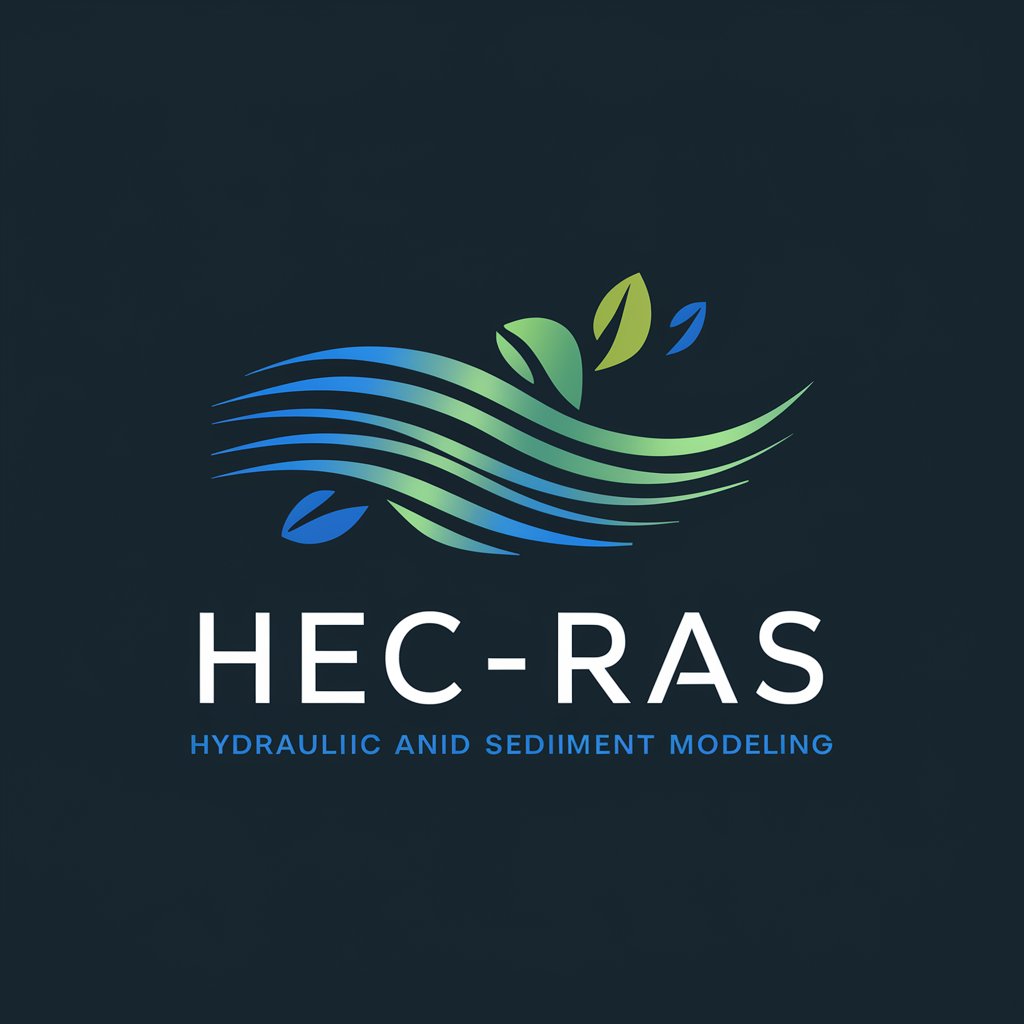HEC-RAS - hydraulic modeling software

Hello! How can I assist you with HEC-RAS today?
AI-powered hydraulic modeling tool
Explain the process of incorporating non-Newtonian effects in HEC-RAS.
How can I model mud and debris flows using HEC-RAS?
What are the key features of the HEC-RAS sediment transport modules?
Describe the process of setting up a 2D sediment transport simulation in HEC-RAS.
Get Embed Code
Introduction to HEC-RAS
HEC-RAS (Hydraulic Engineering Center's River Analysis System) is a software tool developed by the U.S. Army Corps of Engineers for modeling the hydraulics of water flow through natural rivers and other channels. Its primary purpose is to assist engineers in performing one-dimensional hydraulic calculations for a full network of natural and constructed channels. The software is capable of handling complex hydraulic conditions, including flow under bridges, through culverts, and over weirs. Example scenarios include predicting flood levels from storm events, assessing floodplain delineation, and evaluating the effects of changes in channel geometry. Powered by ChatGPT-4o。

Main Functions of HEC-RAS
Steady Flow Analysis
Example
Used for analyzing flow through channels at a constant or steady rate, helpful in designing water structures like dams or for river flood planning.
Scenario
Engineers use steady flow analysis to design levees by simulating flood conditions to understand how high water levels rise during peak flow conditions.
Unsteady Flow Analysis
Example
Simulates changing hydraulic conditions over time, such as those during a storm event.
Scenario
Emergency management agencies simulate storm events to predict how quickly rivers will rise and fall, helping to issue timely flood warnings.
Sediment Transport Capabilities
Example
Predicts how sediment moves and accumulates, which can affect flood risk and habitat.
Scenario
Environmental scientists study sediment transport to understand how riverbank erosion might change the landscape over years, impacting habitats and human structures.
Water Quality Modeling
Example
Analyzes the movement and concentration of pollutants in water bodies.
Scenario
Public health officials use this function to predict the spread of harmful pollutants after a chemical spill into a river system.
Ideal Users of HEC-RAS
Hydraulic Engineers
Use HEC-RAS to design and analyze water flow in projects such as flood control, bridge construction, and river restoration.
Environmental Planners
Employ HEC-RAS for environmental impact assessments, ensuring projects comply with regulations by simulating how they affect local hydraulics.
Emergency Managers
Utilize the software to plan and respond to flood events by modeling flood scenarios and predicting the impact on communities.
Researchers
Use HEC-RAS to conduct hydrological research, studying phenomena like sediment transport and the effect of climate change on river systems.

HEC-RAS Setup and Usage
1. Visit the website yeschat.ai for a free trial without login, also no need for ChatGPT Plus.
Access helpful resources for data analysis and modeling, directly at no cost.
2. Install HEC-RAS
Download and install the HEC-RAS software from the official USACE website, ensuring your system meets the minimum requirements.
3. Prepare input data
Organize terrain, flow, sediment, and geometric data required for modeling. Utilize geographic information system (GIS) tools if necessary.
4. Build the model
Set up the river system, reach, cross-sections, and hydraulic structures in the HEC-RAS project. Define flow boundary conditions, sediment transport, or debris flow parameters.
5. Run simulations and analyze results
Execute simulations based on defined scenarios. Utilize RAS Mapper for advanced result visualization and refine the model as needed.
Try other advanced and practical GPTs
インスタグラム Pro Supporter_JP
Power Your Instagram with AI

DirectGPT
Direct Answers, Powered by AI

App Creator
Empower Your Code with AI

文档速读
AI-powered tool for concise document summaries.

HT DM PL 8TV Writer
Tailor Bollywood Buzz with AI

PM Copilot: User journey map generator
AI-Powered Insights for Better User Journeys

SurveySage
Revolutionizing Surveys with AI

Athena Query Assistant
AI-powered SQL query generation tool

Prompting Coach
Master AI prompting with ease

Efficient Assessment System
Empower Learning with AI Insights

GPT API Key Easy Guide
Streamline your API journey with AI

Eve
Powering Communication with AI

HEC-RAS: Common Questions and Answers
What are the core applications of HEC-RAS?
HEC-RAS is used for hydraulic modeling in river engineering, flood risk assessment, sediment transport, debris flow, and water quality analysis. Its comprehensive tools support unsteady flow, sediment transport, and 2D modeling.
How does HEC-RAS handle sediment transport modeling?
HEC-RAS includes a 1D and 2D sediment transport model, simulating the movement of sediments across channels or floodplains. It uses sediment gradation, load, and flow to assess erosion, deposition, and overall sediment dynamics.
Can I use HEC-RAS to model debris flow?
Yes, HEC-RAS integrates non-Newtonian methods and user-defined parameters like yield stress, viscosity, and bulking options to simulate debris flows. It provides both technical references and troubleshooting guidelines for accurate modeling.
What are the available analysis outputs in HEC-RAS?
Outputs include water surface profiles, velocity, flow distribution, sediment balance, and damage analysis. For debris flow, additional non-Newtonian properties like yield stress and dynamic viscosity are available.
Does HEC-RAS support GIS data integration?
Yes, HEC-RAS interfaces with GIS data through HEC-RAS Mapper, enabling visualization and analysis of results on geographic data layers for better decision-making.
